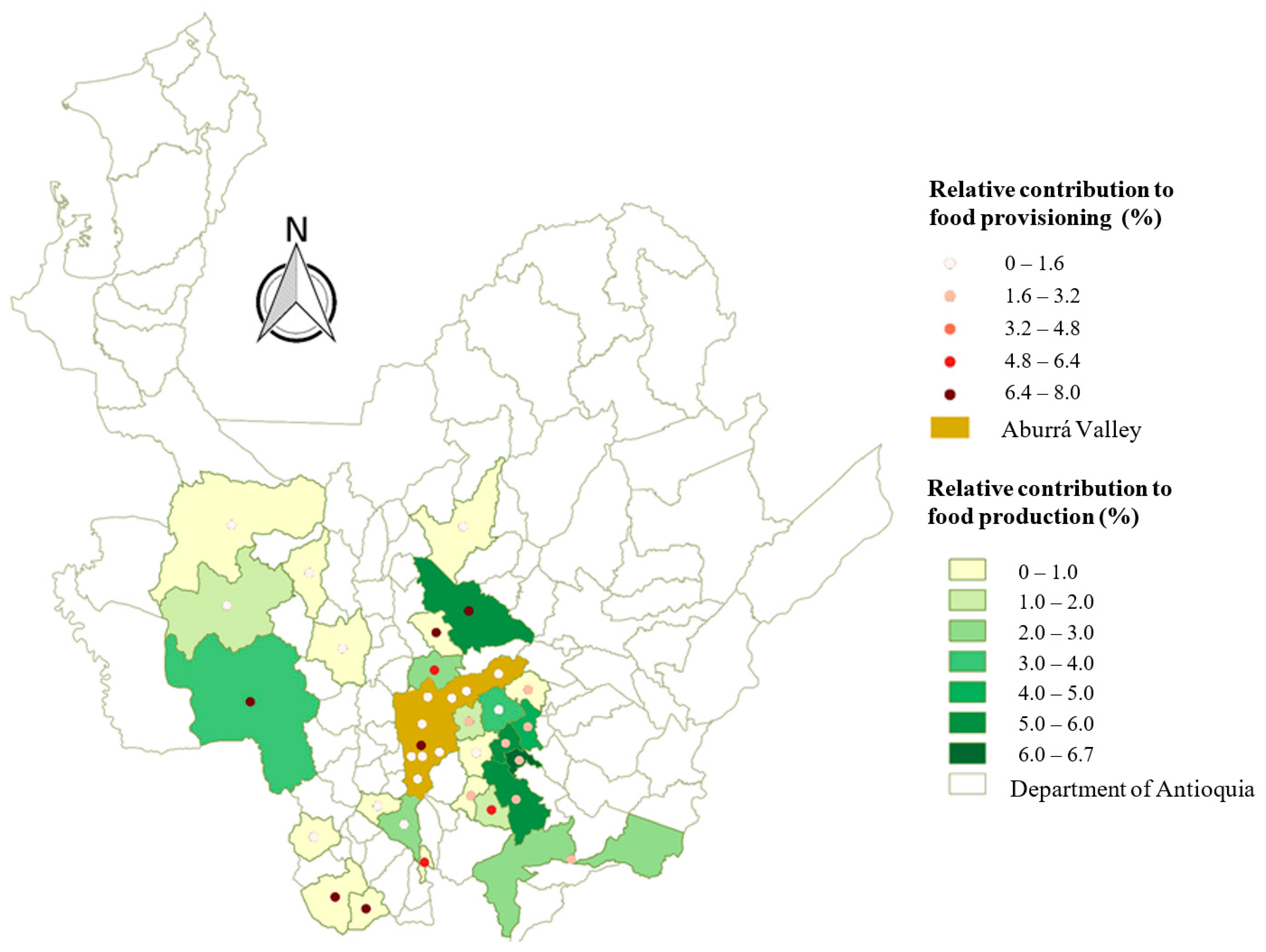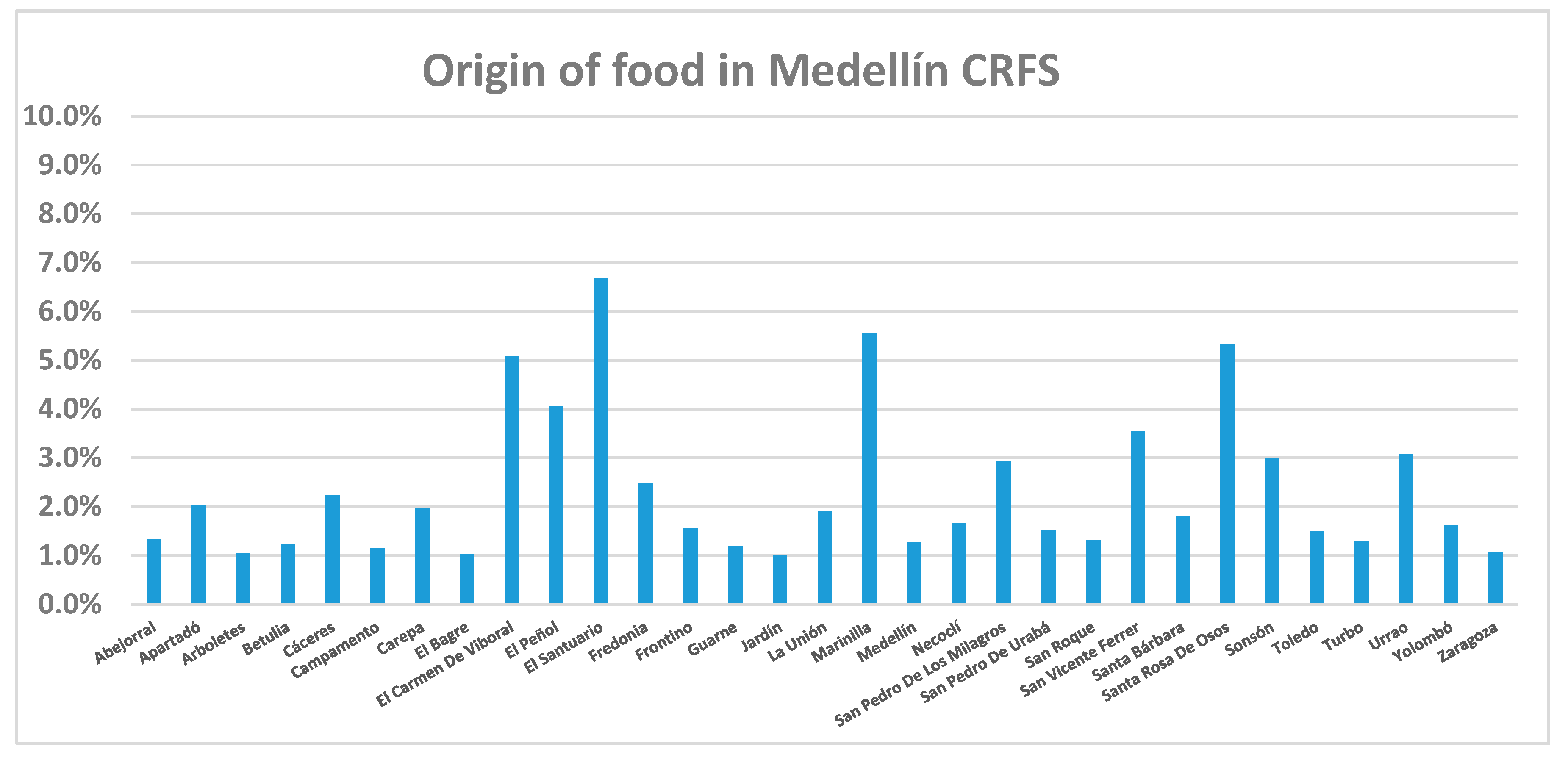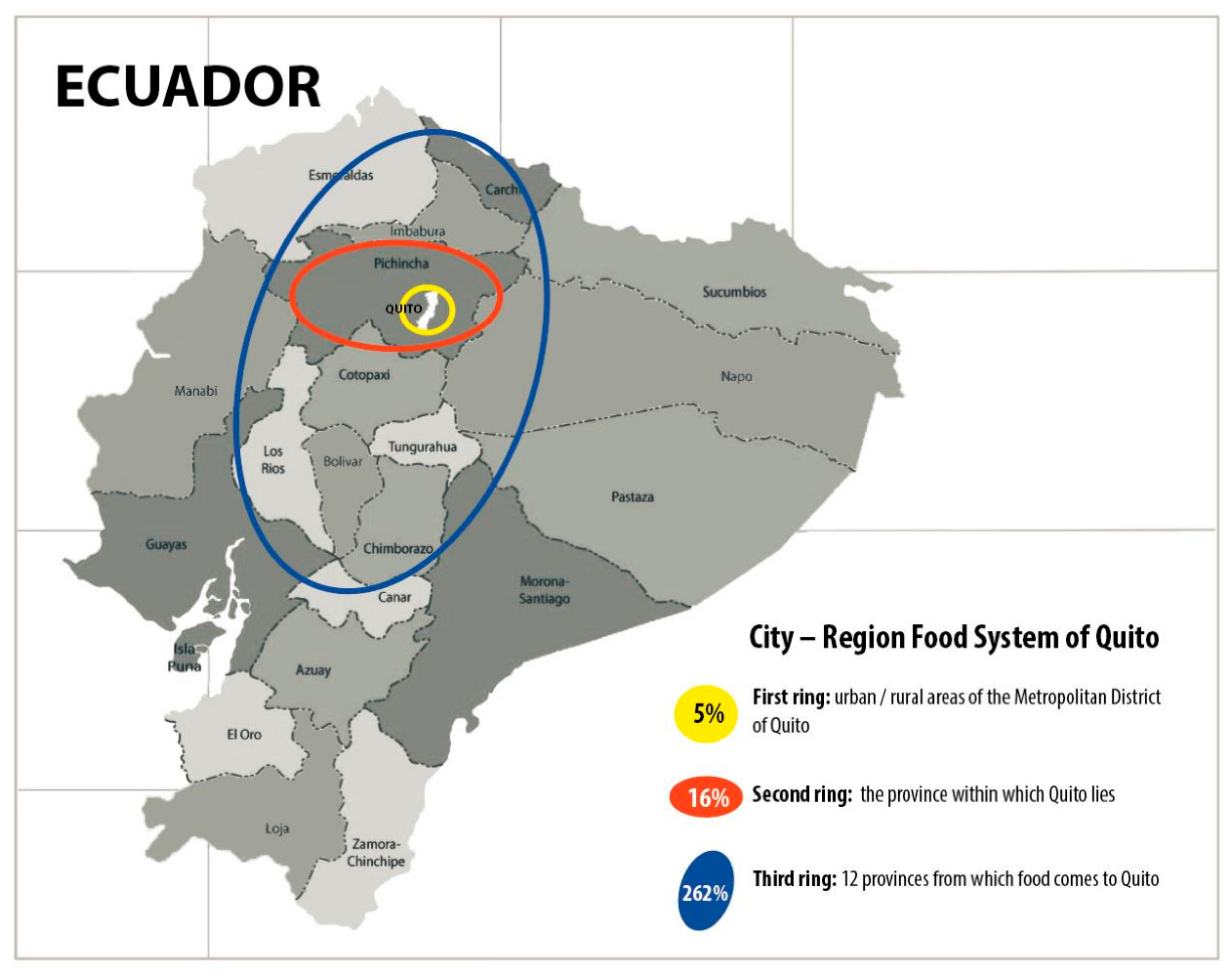Assessing and Planning Sustainable City Region Food Systems: Insights from Two Latin American Cities
Abstract
:1. Introduction
- Food produced in peri-urban areas and rural hinterlands contributes to supplies for both urban areas and their rural surroundings, while urban areas supply the markets upon which agricultural livelihoods depend;
- Rural watersheds supply drinking water to urban areas and provide irrigation for urban, peri-urban, and rural agriculture. Sustainable forms of urban water management can provide financial incentives for the preservation of such (agricultural) watersheds;
- Food losses and waste can be prevented, reduced, and managed, including through the recovery and redistribution of safe and nutritious food for human consumption along the food supply chain from production to consumption, spanning both rural and urban territories;
- Organic and agricultural waste resources produced in urban and rural areas can be used to generate energy and fertilisers, which are used in urban and rural areas, respectively; and
- CRFS characterisation: to understand boundaries, elements, and relations in CRFS and define possible indicators;
- Policy operationalisation: focused data to define policy actions and strategies;
- Policy monitoring: focused data to measure policy impacts and changes over time in relation to baseline data;
- Policy communication: transparent and understandable data to communicate policy aims and impacts to wider audiences and influence policy uptake.
2. The City Region Food System Concept: Developing Territorial Approaches to Urban Food Systems
3. From Theory to Practice: Operationalising the CRFS Concept
3.1. The FAO and RUAF Approach to Assessing and Strengthening CRFS
- To explore and strengthen the city region food production capacity and potential;
- To optimise the regional food processing capacity (that meets food safety standards and provides healthy and sustainable food to the population);
- To retain more of the “local food dollar” and position the city region agri-food sector to contribute directly to the regional economy;
- To increase environmental sustainability and the resilience of the city region food system;
- To develop, implement, and monitor improved and more resilient city region food policies and strategies.
3.2. Initial Findings from Case Studies in Medellín and Quito
3.2.1. Case Study 1: Reinforcing Territorial Integration in the City Region Food System of Medellín
3.2.2. Case Study 2: From Urban Agriculture to Territorial Food Policies in Quito
4. Discussion and Conclusions
4.1. Strategies for Improving the Sustainability and Resilience of CRFS
- Production: enhancing and optimising a more diverse city region food production capacity;
- Processing: providing a sufficient and appropriate regional food processing capacity (that meets food safety standards and provides healthy and sustainable food to the population);
- Distribution: increasing wholesale and distribution of regionally-produced food, making use of diverse outlets, e.g. markets, food supply hubs, and IT platforms;
- Retail: strengthening the presence of food outlets (shops, canteens, markets, street traders) that supply local and fresh healthy food to city residents; improved access to and use of the safe, healthy, nutritious, and culturally-appropriate city region food for vulnerable households/groups in sufficient quantities in the city region;
- Public catering and hospitality: public procurement to increase the offer of healthy, safe, and nutritious food;
- Waste: increasing engagement in the prevention and reduction of food waste and losses throughout the food chain, and increased recycling for safe human consumption;
- Local trade: promoting local consumption of local products to contribute directly to the regional economy;
- Local employment: creation of decent jobs and opportunities throughout the entire food chain, ensuring social inclusion, equity, and fairness for all workers;
- Circular economy: commitment and support to optimised recycling of nutrients, water, and energy for regional food production and wider environmental concerns.
4.2. Mapping and Assessing CRFS
4.3. Need for Developing Integrated Territorial Governance Mechansisms
Acknowledgments
Author Contributions
Conflicts of Interest
References
- United Nations, Department of Economic and Social Affairs, Population Division. World Urbanization Prospects: The 2014 Revision, Highlights; United Nations: New York, NY, USA, 2014; 32p. [Google Scholar]
- Jennings, S.; Cottee, J.; Curtis, T.; Miller, S. Food in an Urbanised World: The Role of City Region Food Systems in Resilience and Sustainable Development; 3Keel: London, UK, 2015. [Google Scholar]
- Lang, T.; Heasman, M. Food Wars: The Global Battle for Mouths, Minds, and Markets; Earthscan: London, UK, 2004. [Google Scholar]
- Berdegué, J.A.; Cazzuffi, C.; Proctor, F.J. Inclusive Rural-Urban Linkages. In Working Group Development with Territorial Cohesion; RIMISP: Santiago, Chili, 2014; 128p. [Google Scholar]
- International Food Policy Research Institute. Global Food Policy Report; International Food Policy Research Institute: Washington, DC, USA, 2017; Available online: http://www.ifpri.org/publication/2017-global-food-policy-report (accessed on 5 June 2017).
- Forster, T.; Getz Escudero, A. City Regions as Landscapes for People, Food and Nature. EcoAgriculture Partners on Behalf of the Landscapes for People; Food and Nature Initiative: Washington, DC, USA, 2014. [Google Scholar]
- International Panel of Experts on Sustainable Food Systems. What Makes Urban Food Policy Happen? Insights from Five Case Studies; International Panel of Experts on Sustainable Food Systems: Louvain-la-Neuve, Belgium, 2017. [Google Scholar]
- De Schutter, O. Report of the Special Rapporteur on the Right to Food. Final Report: The Transformative Potential of the Right to Food; United Nations Human Rights Council: New York, NY, USA, 2014. [Google Scholar]
- Forster, T.; Egal, F.; Getz Escudero, A.; Dubbeling, M.; Renting, H. Milan Urban Food Policy Pact: Selected Good Practices from Cities; Fondazione Giangiacomo Feltrinelli: Milan, Italy, 2015. [Google Scholar]
- Global Forum for Food and Agriculture (GFFA). How to Feed Our Cities?—Agriculture and Rural Areas in an Era of Urbanisation. Communiqué 8th Berlin Agriculture Ministers’ Summit, Berlin, Germany. 16 January 2016. Available online: https://www.bmel.de/SharedDocs/Downloads/Landwirtschaft/Welternaehrung/GFFA_Kommuniqu%C3%A9_2016_EN.pdf (accessed on 5 June 2017).
- United Nations. New Urban Agenda. Quito Declaration on Sustainable Cities and Human Settlements for All. In Proceedings of the United Nations Conference on Housing and Sustainable Urban Developmen, Quito, Ecuador, 17–20 October 2016. [Google Scholar]
- Deutsche Gesellschaft für Internationale Zusammenarbeit (GIZ); RUAF Foundation; Food & Agriculture Organization of the United Nations. City Region Food Systems and Food Waste Reduction—Linking Rural and Urban Areas for Sustainable and Resilient Development; Food & Agriculture Organization of the United Nations: Roma, Italy, 2016. [Google Scholar]
- Dubbeling, M.; Carey, J.; Hochberg, K. The Role of Private Sector in City Region Food Systems. Part I: Overall Analysis Report; RUAF: Leusden, The Netherlands; FBKN: The Hague, The Netherlands, 2016. [Google Scholar]
- Wilkins, J.; Nadeau, R. A Companion to Food in the Ancient World; John Wiley & Sons, Ltd.: West Sussex, UK, 2015; 457p. [Google Scholar]
- RUAF Foundation. City Region Food Systems; Urban Agriculture Magazine: Leusden, The Netherlands, 2015; No. 29; Available online: http://www.ruaf.org/ua-magazine-no-29-city-region-food-systems (accessed on 5 June 2017).
- Van der Ploeg, J.D.; Long, A. (Eds.) Born from Within. Practice and Perspective of Endogenous Rural Development; Van Gorcum: Assen, The Netherlands, 1994; 298p. [Google Scholar]
- Schejtman, A.; Berdegué, J. Towards a Territorial Approach for Rural Development; RIMISP, IPPG Discussion Papers 17; IPPG: Manchester, UK, 2008. [Google Scholar]
- Lamine, C.; Renting, H.; Rossi, A.; Wiskerke, J.S.C.; Brunori, G. Agri-Food systems and territorial development: innovations: New dynamics and changing governance mechanisms. In Farming Systems Research into the 21st Century: The New Dynamic; Darnhofer, I., Ed.; Springer: Dordrecht, The Netherlands, 2012; pp. 229–256. [Google Scholar]
- Peters, C.J.; Bills, N.L.; Wilkins, J.L.; Fick, G.W. Foodshed Analysis and Its Relevance to Sustainability. Renew. Agric. Food Syst. 2009, 24, 1–7. [Google Scholar] [CrossRef]
- Hedden, W.P. How Great Cities are Fed; D.C. Heath and Company: New York, NY, USA, 1929. [Google Scholar]
- Getz, A. Urban foodsheds. Permac. Act. 1991, 24, 26–27. [Google Scholar]
- Kloppenburg, J., Jr.; Hendrickson, J.; Stevenson, G.W. Coming in to the foodshed. Agric. Hum. Values 1996, 13, 33–42. [Google Scholar] [CrossRef]
- Metcalf, S.S.; Widener, M.J. Growing Buffalo’s capacity for local food: A systems framework for sustainable agriculture. Appl. Geogr. 2011, 31, 1242–1251. [Google Scholar] [CrossRef]
- Feagan, R. The place of food: Mapping out the ‘local’ in local food systems. Prog. Hum. Geogr. 2007, 31, 23–42. [Google Scholar] [CrossRef]
- Morgan, K. Feeding the City: The Challenge of Urban Food Planning. Int. Plan. Stud. 2009, 14, 341–348. [Google Scholar] [CrossRef]
- Moragues Faus, A.; Morgan, K. Reframing the foodscape: The emergent world of urban food policy. Environ. Plan. A 2015, 47, 1558–1573. [Google Scholar] [CrossRef]
- Renting, H.; Schermer, M.; Rossi, A. Building Food Democracy: Exploring Civic Food Networks and Newly Emerging Forms of Food Citizenship. Int. J. Sociol. Agric. Food 2012, 19, 289–307. [Google Scholar]
- Sonnino, R. The new geography of food security: Exploring the potential of urban food strategies. Geogr. J. 2014. [Google Scholar] [CrossRef]
- Barling, D.; Lang, T.; Caraher, M. Joined-up food policy? The trials of governance, public policy and the food system. Soc. Policy Adm. 2002, 36, 556–574. [Google Scholar] [CrossRef]
- Wiskerke, J.S.C. On Places Lost and Places Regained: Reflections on the Alternative Food Geography and Sustainable Regional Development. Int. Plan. Stud. 2009, 14, 369–387. [Google Scholar] [CrossRef]
- Lang, T.; Barling, D.; Caraher, M. Food Policy. Integrating Heath, Environment & Society; Oxford University Press: Oxford, UK, 2009. [Google Scholar]
- Morgan, K.J.; Sonnino, R. The urban foodscape: World cities and the new food equation. Camb. J. Reg. Econ. Soc. 2010, 3, 209–224. [Google Scholar] [CrossRef]
- Baker, L.; de Zeeuw, H. Urban Food Policies and Programmes. In Cities and Agriculture, Developing Resilient Urban Food Systems; de Zeeuw, H., Drechsel, P., Eds.; Routledge: London, UK, 2015; 431p. [Google Scholar]
- Pimbert, M. Towards Food Sovereignty; The gatekeeper series (141); IIED: London, UK, 2009; 24p. [Google Scholar]
- Food and Agriculture Organization of the United Nations (FAO); RUAF Foundation. A Vision for City Region Food Systems. 2015. Available online: http://www.fao.org/3/a-i4789e.pdf (accessed on 5 June 2017).
- Desakota Study Team. Re-Imagining the Rural-Urban Continuum: Understanding the Role Ecosystem Services Play in the Livelihoods of the Poor in Desakota Regions Undergoing Rapid Change; Institute for Social and Environmental Transition-Nepal (ISET-N): Kathmandu, Nepal, 2008; 125p, ISBN 978-9937-8019-1-1. [Google Scholar]
- High Level Panel of Experts (HLPE). Food Losses and Waste in the Context of Sustainable Food Systems; A Report by the High Level Panel of Experts on Food Security and Nutrition of the Committee on World Food Security; HLPE: Rome, Italy, 2014. [Google Scholar]
- Laidlaw, J. Food Security—A Core Component of a Leading City’s Transformation Agenda; Global Compact Cities Programme; RMIT University: Melbourne, Australia, 2015. [Google Scholar]
- Distrito Metropolitano De Quito. Plan Estratégico Metropolitano de Desarrollo y de Ordenamiento Territorial del Distrito Metropolitano de Quito; Alcaldia de Quito: Quito, Ecuador, 2015. (In Spanish) [Google Scholar]
- Rodriguez, A.; Proaño, I. Quito Siembra: Agricultura Urbana; CONQUITO AGRUPAR: Quito, Ecuador; Alcaldia de Quito: Quito, Ecuador, 2016; Available online: http://www.conquito.org.ec/wp-content/ uploads/2016/11/QUITO_SIEMBRA_AGRICULTURA_URBANA_CONQUITO.pdf. (accessed on 15 August 2017). (In Spanish)
- Carey, J. Who Feeds Bristol? Towards a Resilient Food Plan; Bristol Green Capital and Bristol City Council: Bristol, UK, 2011. [Google Scholar]



© 2017 by the authors. Licensee MDPI, Basel, Switzerland. This article is an open access article distributed under the terms and conditions of the Creative Commons Attribution (CC BY) license (http://creativecommons.org/licenses/by/4.0/).
Share and Cite
Dubbeling, M.; Santini, G.; Renting, H.; Taguchi, M.; Lançon, L.; Zuluaga, J.; De Paoli, L.; Rodriguez, A.; Andino, V. Assessing and Planning Sustainable City Region Food Systems: Insights from Two Latin American Cities. Sustainability 2017, 9, 1455. https://doi.org/10.3390/su9081455
Dubbeling M, Santini G, Renting H, Taguchi M, Lançon L, Zuluaga J, De Paoli L, Rodriguez A, Andino V. Assessing and Planning Sustainable City Region Food Systems: Insights from Two Latin American Cities. Sustainability. 2017; 9(8):1455. https://doi.org/10.3390/su9081455
Chicago/Turabian StyleDubbeling, Marielle, Guido Santini, Henk Renting, Makiko Taguchi, Louison Lançon, Juan Zuluaga, Luca De Paoli, Alexandra Rodriguez, and Verónica Andino. 2017. "Assessing and Planning Sustainable City Region Food Systems: Insights from Two Latin American Cities" Sustainability 9, no. 8: 1455. https://doi.org/10.3390/su9081455




